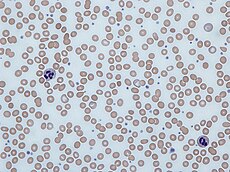Team members
Names / Roles:
- [Khairunisa] (Leader)
- [Stacey] (Editor)
- [Karen] (Researcher)/(Editor)
- [Shayna] (Researcher)
Meaning / Definition
In this section, include a brief description of the disorder or disease. You may include picture(s) or video(s) to illustrate your points.
Anemia or anaemia (/əˈniːmiə/; also spelled anæmia) is usually defined as a decrease in the amount of red blood cells (RBCs) orhemoglobin in the blood.[1][2] It can also be defined as a lowered ability of the blood to carry oxygen.[3] When anemia comes on slowly the symptoms are often vague and may include: feeling tired, weakness, shortness of breath or a poor ability to exercise. Anemia that comes on quickly often has greater symptoms which may include: confusion, feeling like one is going to pass out, and increased thirst. There needs to be significant anemia before a person becomes noticeably pale. There may be additional symptoms depending on the underlying cause.[4]
website :
https://en.wikipedia.org/wiki/Anemia


picture by Wikipedia Picture by Google
Human blood from a case of iron-deficiency anemia
Causes and Effects
In this section, while using a little medical jargon as possible,
1) include a description of the condition(s) or situation(s) causing the disorder or disease;
2) include a description of the effect(s), outcome(s) or impact(s) on the patients' lives as a result of having the disorder or disease.
You may include picture(s) or video(s) to illustrate your points.
1) Broadly, causes of anemia may be classified as impaired red blood cell (RBC) production, increased RBC destruction (hemolytic anemias), blood loss and fluid overload (hypervolemia). Several of these may interplay to cause anemia eventually. Indeed, the most common cause of anemia is blood loss, but this usually does not cause any lasting symptoms unless a relatively impaired RBC production develops, in turn most commonly by iron deficiency.
2) When anemia comes on slowly the symptoms are often vague and may include: feeling tired, weakness, shortness of breath or a poor ability to exercise. Anemia that comes on quickly often has greater symptoms which may include: confusion, feeling like one is going to pass out, and increased thirst. There needs to be significant anemia before a person becomes noticeably pale.
Website: https://en.wikipedia.org/wiki/Anemia
Video: https://youtu.be/IfmJeWW4OyQ
Signs and Symptoms
In this section, while using a little medical jargon as possible, include a description of the signs and symptoms exhibited by people having the disorder or disease. You may include picture(s) or video(s) to illustrate your points.
Fatigue (PDQ)  (National Cancer Institute)
(National Cancer Institute)
... caused by biologic therapy Fatigue caused by surgery Anemia is a common cause of fatigue. Side effects related to nutrition may cause or increase fatigue
- Extreme fatigue(Tired)
- Pale skin
- Weakness
- Shortness of breath
- Chest pain
- Headache
- Dizziness
- Cold hands and feet
- Brittle nails(Easily broken nails)
- Fast heartbeat
- Poor appetite, especially in infants and children with iron deficiency anemia
- An uncomfortable tingling or crawling feeling in your legs (restless legs syndrome)
Website: http://www.mayoclinic.org/diseases-conditions/iron-deficiency-anemia/basics/symptoms/con-20019327
Prevention and Treatment
In this section, while using a little medical jargon as possible,
1) include a description of the steps to prevent getting the disorder or disease (if it cannot be prevented, do explain why);
2) include a description of the treatment of the disorder or disease (if it cannot be treated, do explain why) or the steps to lessen its signs or symptoms.
You may include picture(s) or video(s) to illustrate your points.
1) Ways to prevent Anaemia
1. Eat a diet rich in iron
2. Cook using iron pots and pans
3. Get plenty of vitamin C
4. Take iron supplements(To make sure you're getting enough iron)
2) Treatments for anemia depend on cause and severity. Vitamin supplements given orally (folic acid or vitamin B12) or intramuscularly (vitamin B12) will replace specific deficiencies
1)Website: http://www.wikihow.com/Prevent-Anemia
2)Website: https://en.wikipedia.org/wiki/Anemia
Link to Other Illnesses or Diseases
In this section, while using a little medical jargon as possible, include a description of the illness(es) or disease(s) that may occur as a result of having this disorder or disease.
You may include picture(s) or video(s) to illustrate your points.
Anemia of chronic disease. Certain chronic diseases — such as cancer, HIV/AIDS, rheumatoid arthritis, Crohn's disease and other chronic inflammatory diseases — can interfere with the production of red blood cells, resulting in chronic anemia. Kidney failure also can cause anemia.
Website: http://www.mayoclinic.org/diseases-conditions/anemia/basics/causes/con-20026209
References
Plagiarism is a strongly discouraged.
In this section, include the links of all websites you obtained information from to complete your health science wiki page.
For example:
WebMD (http://www.webmd.com/)
https://en.wikipedia.org/wiki/Anemia
https://en.wikipedia.org/wiki/Anemia
https://youtu.be/IfmJeWW4OyQ
http://www.mayoclinic.org/diseases-conditions/iron-deficiency-anemia/basics/symptoms/con-20019327
http://www.wikihow.com/Prevent-Anemia
https://en.wikipedia.org/wiki/Anemia
http://www.mayoclinic.org/diseases-conditions/anemia/basics/causes/con-20026209
Comments (4)
Mr Reuben Ng said
at 7:42 pm on Jun 9, 2015
Please start on your project soon!
Mr Reuben Ng said
at 1:43 pm on Jun 17, 2015
Good! Do start on your "cause and effects" soon
Mr Reuben Ng said
at 3:22 pm on Jun 27, 2015
Do remove your highlights.
class1a2group3 said
at 6:35 pm on Jul 12, 2015
Some of the members cant do as they does not have a computer all of us do individually
You don't have permission to comment on this page.